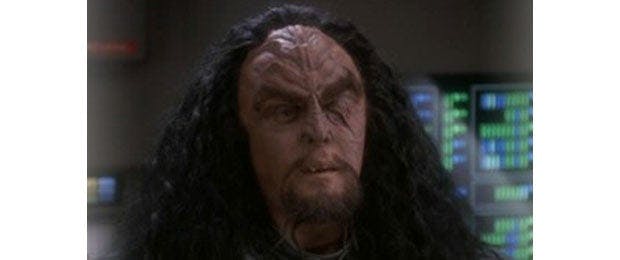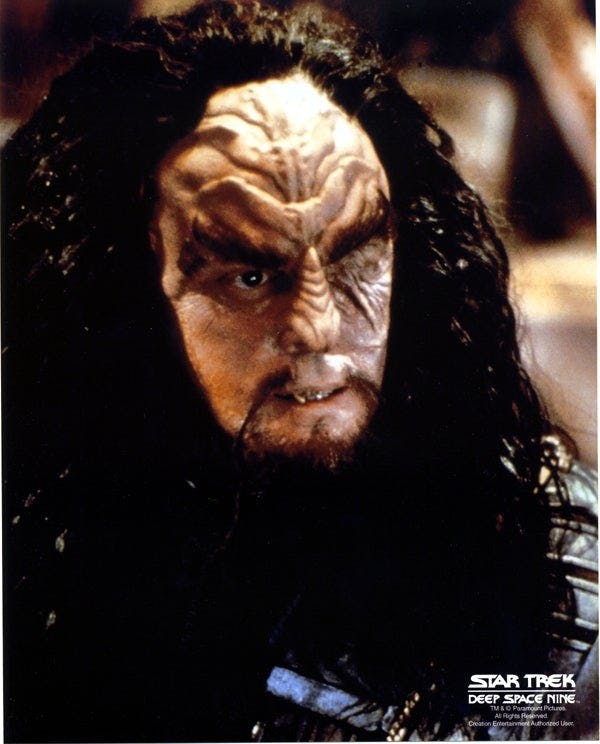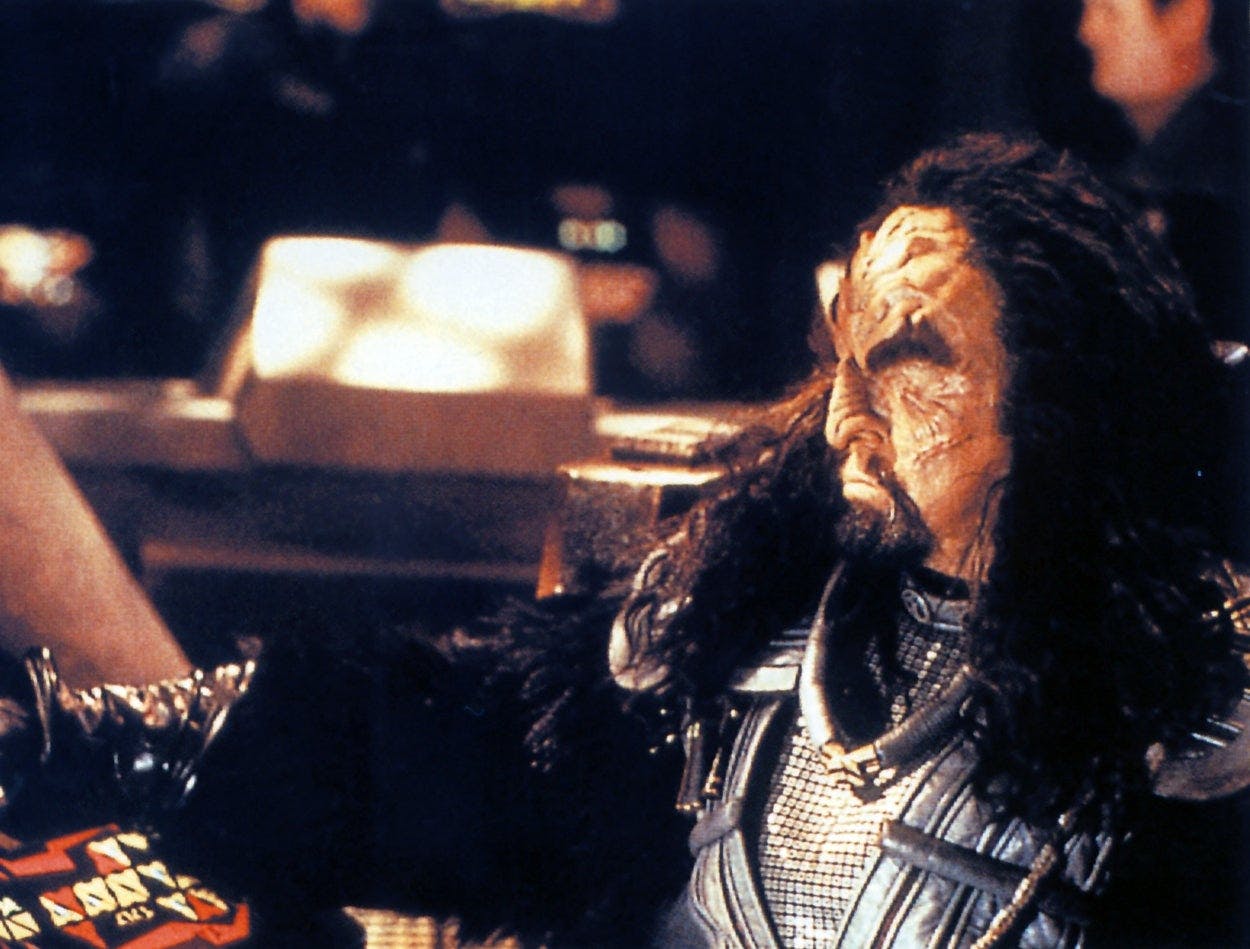Published Jun 29, 2019
J.G. Hertzler Reflects on His Many 'Trek' Roles
The self-described 'blue-collar actor' sat down with StarTrek.com to parse out Martok, Kolos, and everyone in between.

This interview was originally published in January 2011
J.G. Hertzler was all over Star Trek, especially Deep Space Nine. Chances are you didn’t even realize you saw him as often as you did — in part because he used so many names (J.G. Hertzler, John Noah Hertzler, and Garman Hertzler, to name a few.) and in part because the actor tackled so many Trek roles. He appeared first as the Vulcan Captain and Prophet in the DS9 pilot “Emissary,” before returning several seasons later as the Changeling impostor version of the Klingon General Martok in the year-four finale “The Way of the Warrior,” and year-five opener “Apocalypse Rising.” He played the “real” Martok more than 20 times across seasons five, six and seven, even surviving the momentous events of the series finale, “What You Leave Behind.” Hertzler also portrayed the human illustrator in “Far Beyond the Stars,” the Changeling Laas in “Chimera” and a holosuite guest in “What You Leave Behind.”
However, Hertzler’s Trek adventure was only just beginning with DS9. The actor — whose non-Trek credits include Quantum Leap, Zorro, Pirates of Silicon Valley, Six Feet Under, and numerous stage roles — turned up as the Hirogen Fighter in the Voyager episode “Tsunkatse.” He went onto appear on Enterprise as the Klingon advocate Kolos in “Judgment,” and a Klingon Commander in “Borderland." Need more? Hertzler was involved in several Klingon-themed Trek video games, penned a pair of Trek novels, The Left Hand of Destiny duology and co-starred as Koval in the fan film Star Trek: Of Gods and Men.
These days, Hertzler lives in the Finger Lakes region of New York these days and focuses his energy on teaching drama at Cornell University and raising his daughter. StarTrek.com caught up with Hertzler for the following interview.

StarTrek.com
You made your first DS9 appearance as the Vulcan captain in “Emissary.” What do you recall of the experience?
J.G. Hertzler: Well, it was pretty exciting because I think I had a little scene with Patrick Stewart. I’d spent several summers working with Patrick, because he ran a Shakespeare workshop on the lot at Paramount on Saturdays. But doing that first show, it was pretty incredible to me. This was Star Trek. The fact that I’d ever come to work on a Star Trek show and drive through the arches of Paramount Pictures to get there? It hadn’t occurred to me that, as an actor, that would ever happen. I’m a blue-collar actor, and so that was just a remarkable experience. Being a part of the big dream factory called Hollywood, I never thought I’d go there. I was just going to do theater in Washington, D.C., and the world took me to a different place.
How did Martok come along?
JGH: I’d auditioned for Trek a lot. I’d guess about 14 times. I’d come in, punch my card and people would say, “Good to see you again. What are you reading this time?” I’d say, “Oh, a Cardassian,” or whatever it was. I finally told my agent, “Don’t send me up to Star Trek anymore. They’ve seen everything I could possibly ever do and I haven’t gotten a role. Don’t waste their time or my time.” Real soon after that, I had an audition [for something else]. I was sitting outside, angry about something, and [DS9 casting director] Ron Surma came by. He said, “Oh, John, you might be good for this. Take a look, then come in and read.” It was General Martok. I auditioned and I said to myself, “I’m not going to be your usual Klingon. I’m not going to be offensive, overbearing, self-possessed, arrogant, boorish. I’m going to be Patrick Stewart as a Klingon.”
So I did a quiet and cerebral audition and when I finished, they said, “Do you know what a Klingon is?” I said, “Oh, you want it to be loud, aggressive, abrasive, obnoxious, boorish…” They said, “Yes.” So I did it with that in mind, and I threw a chair against a wall. They had an old plaster wall and it was a metal chair, and one of the legs stuck in the wall a little bit before it fell out. And I caught my thumbnail when I tossed it. I ripped about half my thumbnail off. You must understand, I played linebacker in college, and to play football, especially linebacker, it’s a barely controlled rage. So that’s where I’m coming from in terms of life, barely controlled rage. So the linebacker welled up in me and there I was, with a chair in the wall and blood dripping from my thumb, and I ranted and roared. They said, “Well, thank you,” and they looked a little worried. I heard a day or two later that I got the role.
At what point were you told Martok would be a recurring character?
JGH: It was just a one or a two-episode part. General Martok appeared and then it was Ira Steven Behr or Robert Hewitt Wolfe or Ron Moore — I can’t remember — who said it was the original intent to have Gowron in “Way of the Warrior” and “Apocalypse Rising” shown to be a Dominion replacement, a clone, rather than the Martok figure, but they felt that was too pat or too easy. So they made Martok the clone and blew me up. Somewhere along the line, they said, “Worf has a friend,” meaning Martok, and that potential relationship attracted them.
I had both eyes as a clone, but as the real Martok, I was a one-eyed Klingon. Ira said, “Don’t worry about that eye. We’ll give you an artificial eye so you have both eyes again.” I said, “No, no, no. Don’t do that, Ira. First of all, I don’t think a Klingon would care how many eyes he has, as long as he has one. Secondly, I just think it’s more interesting if I can be a one-eyed Klingon.” I might’ve been subconsciously thinking of Christopher Plummer as Chang.
Of your many episodes as Martok, which one or two stand out as the character’s finest hours?
JGH: One was “Soldiers of the Empire,” which LeVar Burton directed. The other was “Once More unto the Breach,” which Allan Kroeker directed. I think “Once More unto the Breach” was my favorite because I was dealing with John Colicos as Kor, which was an honor. And I got to do a tiny bit of writing in that one. I asked Ron if I could add a line to a long speech I had at the end of the episode. I added, “Unfortunately, my father did not live to see that day.” That, for me, rounded out the character’s choice to never forgive, to take his hatred of Kor and his resentment to the grave. It was important to me to not forgive Kor on behalf of my father.
They said, “People like Martok. They want to root for him.” I said, “You know, it really doesn’t matter.” As a character, as an actor, it’s a lot more exciting to play that “human failure” of never forgiving than it is to forgive. You might be a better angel to forgive, but there aren’t that many angels in the Klingon nature.

StarTrek.com
You played different characters in “Chimera” and “Far Beyond the Stars”…
JGH: I don’t know why they hired me to do “Chimera,” to be honest. I did my best to disguise my voice, but people still recognized it. Actually, some people say, “Oh, you were Laas? I had no idea.” That’s rewarding for an actor to hear. I was basically trying to do Shatner, but at a higher pitch.
I loved that piece because I got to work with Rene Auberjonois the whole time, and I’d never gotten to do much with him before, other than 'harrumph' at each other as our grumpy characters. The thing I remember about “Far Beyond the Stars,” aside from the tremendous story, is that I draw and sketch and paint. I drew everybody that was sitting around that table. I sketched all the players in their 1950s looks. I turned those sketches into the props department at the end of the shoot. That was stupid of me. I had no idea about the convention world at that point, but it would’ve been nice to have them in order to show them to people. Anyway, I thought that episode was one you could have built an entire series from.
What comes to mind about your Voyager and Enterprise guest shots?
JGH: I’d never have thought that the Hirogen on Voyager would take more makeup and appliance time than a Klingon, but it took longer. That was astounding. I did two bits on Enterprise. I was basically blown up immediately in “Borderland,” but the real thrill on that was that I got to wear Michael Ansara’s costume. My Klingon costume was the Kang costume from when Kang, Kor, and Koloth came onto DS9. I’d been looking through things to wear and I said, “Well, what about this?” They said, “That was Ansara’s. We’re not sure it’ll fit you.” And it fit me perfectly. I grew up watching Michael Ansara as Cochise in Broken Arrow and he was one of my personal heroes. To wear his Klingon togs was fabulous.
Let’s catch up on what you’re doing now. You still make convention appearances, sometimes in costume as Martok, but you live in the Finger Lakes region of New York and you’re teaching drama, right?
JGH: I enjoy the conventions. I see a lot of Bob O’Reilly (who played Gowron). I’ve done some video games. I did BioShock and BioShock 2 and Dead Space, but I’ve never seen them. And the past four years I’ve been teaching theater at Cornell. It’s occupied my every waking hour. I just did a radio production of a recreation of Orson Welles’ 1939 broadcast of A Christmas Carol. I produced and directed that, and it aired here in the Finger Lakes. That was a huge hit and hopefully, it’s the start of something I’ll do on a regular basis.
This interview has been edited and condensed.
J.G. Hertzler is set to appear this summer at Star Trek Las Vegas 2019.

